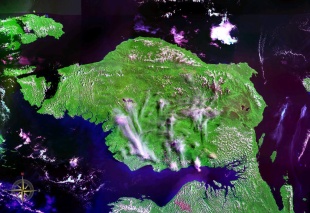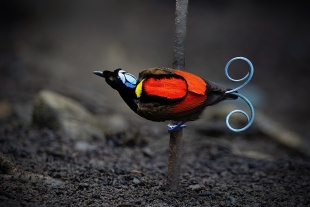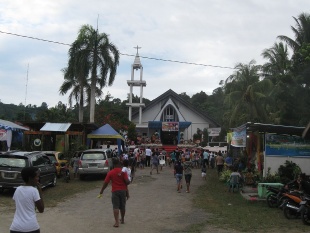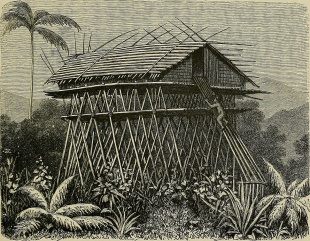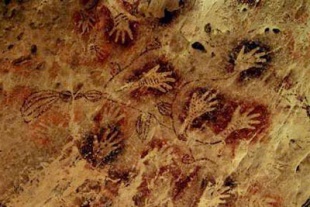PAPUA
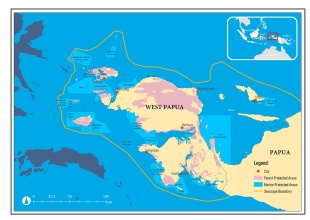
Papua is the common name that refers to the western half of the Island of New Guinea (Indonesian New Guinea). Papua is the official name for the region as a whole and the name of at least one of the current provinces within it. Western New Guinea is a descriptive name for the western half of the island of New Guinea, with the country of Papua New Guinea occupying the eastern half. West Papua is also commonly used, particularly by those who refer to the region as a whole. The region was previously known as Netherlands New Guinea, West Irian, and Irian Jaya.
After Indonesia took control of the territory in 1969, it was called Irian Barat (West Irian). After it was integrated into Indonesia as the its 26th province in 1973 West Irian was renamed Irian Jaya. Irian means hot land" in the Biak language of northern Papua. Jaya means "victorious” in Bahasa Indonesian. It was a name given to the area by Suharto (president of Indonesia from 1967 to 1998). Irian is also an acronym for “Ikut Republik Indonesia Anti-Nederland” (To Follow the Anti-Netherlands Republic of Indonesia). Local people prefer the name West Papua.
Indonesia’s The national parliament changed the name back to its original name of Papua in October 2001. In 2003, Indonesian President Megawati set in motion a tortuous three-year process by which the northwestern portion was split off to form the new province of Irian Jaya Barat (West Irian Jaya), with the eastern two-thirds retaining the name Papua. Irian Jaya Barat was renamed West Papua (Papua Barat) in 2007. Further division of Papua was blocked at the time. In 2022, the Indonesian parliament voted to create four new provinces in the Papua region by splitting the original Papua province into Papua, Central Papua, Highland Papua, and South Papua. Separately, the West Papua province was split into West Papua and Southwest Papua provinces.
A) The Original Papua province became four provinces:
1) Papua (the remaining central northern coastal area)
2) Papua Tengah (Central Papua)
3) Papua Pegunungan (Highland Papua)
4) Papua Selatan (South Papua)
B) West Papua province was split into two:
5) Papua Barat (West Papua)
6) Papua Barat Daya (Southwest Papua)
RELATED ARTICLES:
ETHNIC GROUPS IN NORTHERN PAPUA AND THE BIRD'S HEAD (VOGELKOP) OF NEW GUINEA factsanddetails.com
HIGHLAND GROUPS OF WEST NEW GUINEA — EIPO, DAMAL, EKAGI — AND THEIR HISTORY, LIFE AND SOCIETY factsanddetails.com
DANI AND PEOPLE OF THE BALIEM VALLEY: HISTORY, RELIGION, WHERE THEY LIVE factsanddetails.com
LIFE OF DANI PEOPLE OF WESTERN NEW GUINEA: SOCIETY. FOOD, SEXUALITY factsanddetails.com
BALIEM VALLEY: HISTORY, PEOPLE, TRAVEL, HIGHLIGHTS factsanddetails.com
PAPUA — THE INDONESIA PART OF NEW GUINEA — NAMES, HISTORY, PEOPLE factsanddetails.com
HISTORY OF PAPUA factsanddetails.com
PAPUA factsanddetails.com
FIRST PEOPLE IN NEW GUINEA ioa.factsanddetails.com
UNREST AND LIMITED AUTONOMY IN PAPUA SINCE THE OUSTER OF SUHARTO IN 1998 factsanddetails.com
Southwest Papua Province

Highland Papua (darker blue)
Papua (purple)
South Papua (dark green)
Southwest Papua (light blue)
West Papua (olive green)
Southwest Papua (Indonesian: Papua Barat Daya) is Indonesia’s 38th province, formally separated from West Papua in December 2022. Despite its name, the province lies on the northwestern edge of the island, not the southwest. It comprises the Greater Sorong area (Sorong Raya): Sorong City, Sorong Regency, South Sorong Regency, Maybrat Regency, Tambrauw Regency, and Raja Ampat Regency.
Located on the northwestern flank of the Doberai (Bird’s Head, Vogelkop) Peninsula, the province includes the famed Raja Ampat Islands at its westernmost extent. This protected marine region is known for its exceptional biodiversity, from extensive coral reefs to leatherback turtles, manta rays, and whale sharks. Geographic boundaries of Southwest Papua province are the Pacific Ocean in the north; Seram Sea in the west; Banda Sea in the south; and West Papua province in the east.
Sorong, the provincial capital, functions as a major oil and gas hub and the primary gateway to Papua, supported by modern port and airport infrastructure. Southwest Papua also contains significant intact ecosystems—tropical rainforests, highlands, and rich wildlife habitats. Tambrauw Regency is especially noted for birdwatching and has declared itself a “Conservation Regency” to promote ecotourism and sustainable development.
This provincehas immense natural resource potential including agriculture, mining, forest products and eco-tourism. Pearls and sea weed are the main trade goods of Raja Ampat Regency, while Sorong Selatan Regency is the only regency producing unique traditional woven clothes called Timor clothes. Cenderawasih Bay National Park, situated in Wondama Gulf Regency is also the main natural tourism in this Province. And of course, many visitors come to enjoy the marine bio-diversity of Raja Ampat.
West Papua Province
West Papua (Indonesian: Papua Barat), formerly Irian Jaya Barat (West Irian), is an Indonesian province located in Indonesia Papua. It covers most of the two western peninsulas of the island of New Guinea: the eastern half of the Bird's Head Peninsula (or Doberai Peninsula) and the whole of the Bomberai Peninsula, along with nearby smaller islands.
The province is bordered to the north by the Pacific Ocean; to the west by Southwest Papua Province, the Halmahera Sea and the Ceram Sea; to the south by the Banda Sea; and to the east by the province of Central Papua and the Cenderawasih Bay.
Manokwari is the province's capital and largest city. With an estimated population of 578,700 in mid-2024 (comprising 304,140 males and 274,560 females), West Papua is the second-least-populous province in Indonesia after South Papua, following the separation off in December 2022 of the western half of the Bird's Head Peninsula to create the new province of Southwest Papua, containing 52% of what had been West Papua's population.[2] Its population density is similar to that of Russia.
Western West Papua offers good diving and trekking. There are some lovely beaches and remote rain forest but as rule places are often difficult and/or expensive to reach. Highlight include diving among the World War II ship and plane wrecks near Manokwari and trekking in the in forests and mountains of Pegunungan Arfak and Wondiwoi Mountains Reserve. Tourism Office: Jl Merdeka 13, Manokwari, Papua Barat Telp/Fax: +62-967-212646
Climate of Papua
Much of Papua is out of range of the monsoon cycles. The wet and dry patterns are irregular, with many places getting over 200 centimeters of rain a year. The driest months tend be between May and October although heavy rains can fall in that time and often do. Along the northern coast it rainiest and often very windy from November to March. Along the southern coast it rainiest and often very windy from April to October.
The highlands are temperate and reasonably comfortable with mean temperatures averaging between 26̊C and 15̊C. The best times to visit the Baliem Valley is after March when the weather is a little drier. The lowlands are considerable hotter than the highlands. Southern Papua is located at the edge of the monsoon belt. The hottest month is December, the coolest is June. Rainfall regularly exceed 450 centimeters a year. Some places in the highlands get more than 600 centimeters a year.
Travel Documents in Papua
Foreigners traveling in some parts of Papua are required to have a travel permit known as a surat jalan. The issuing policy and requirements are confusing. Some places you can visit without one. Some places require one but allow you obtain after you get there. Other places require you get it before you arrive. Most people fly into Jayapura, where one isn’t required. The best thing to do is inquire there what the policies are in the places you plan to visit and obtain a surat jalan there eif you need one.
Suray jalan are generally obtained at police stations or branches of the provincial police force. Biak, Soromg and Jayabura are the easiest places to obtain them because they have the most contact with foreigners. The period of time in which the surat jalan is valid varies from a week to month. Try to get one for as long a period as you can.
The process of getting one usually takes about an hour. You need two passport-size photographs and need to provide a list of all the places you plane to visit. The fee is generally not very high. Make several photocopies. When you arrive in places that require a surat jalan you generally need to report to the police station there and supply a photocopy of the surat jalan to your hotel. Most visitors have to fly to Jayapura first to obtain permits for traveling elsewhere in province. The $45 permits can usually be obtained in a few hours with the help of a travel agency or hotel.
Traveling in Birds of Paradise Country
Jennifer S. Holland wrote in National Geographic, “Much of New Guinea remains wild as ever, its fauna still not fully explored. In December 2005 scientists surveying the Foja Mountains in Indonesia's Papua Province, the western half of the island, came upon the Berlepsch's parotia, a bird of paradise with half a dozen springy feathers on its head. This legendary species was previously known only from a few partial specimens collected more than a century ago. [Source: Jennifer S. Holland, National Geographic, Tim Laman, July 2007]
“Farther east, in Papua New Guinea's Crater Mountain reserve, the forest grows dense to the mountain's summit, forming a canopy that blocks all but the thinnest rays of sun. Birdsong rings out in the gloom, a hoot here, a trill there, a melodious whistle, a harmonic tone as when a finger circles the rim of a glass. Drenched by nearly 300 inches (760 centimeters) of rain a year, this highland terrain is forever dripping. The forest floor, composed of layer on layer of organic material, is a wet sponge underfoot. And always, from somewhere below, comes the muted rush of a cold river spiriting away last night's rain.
“Trails are rutted and mud-slick, swallowing boots and bruising the ankles of a first-time visitor. But the local women and children, who for a few kina will carry heavy gear and even lead you by the hand, tread lightly on bare feet. Pull out pictures of what you're looking for, and the men will lead you on long, clambering hikes, their machetes swinging to clear a path to where the birds of paradise hold court.
“Even with local guides, finding the elusive birds can be daunting. Their calls, unique to each species, tantalize you. Squawks, mews, and nasal bursts reveal Carola's parotia. A ghostly aria? That's the buff-tailed sicklebill. The superb bird of paradise seems to throw its metallic voice, sending you off course. At higher elevations the King of Saxony bird crackles like radio static. And within earshot, the rat-a-tat-tat of the brown sicklebill could be machine-gun fire.
“At last a glimpse of a forest dance floor reveals a weird, obsessive performance. The magnificent bird of paradise, with its baby blue cap and filigree tail, snaps into the same crisp displays again and again, puffing up its breast to show off its glossy chest plate. The parotia spends hours cleaning its court and practicing its moves, often watched by younger males eager to learn the ropes. The buff-tailed sicklebill settles on the same perch at the same time every evening, popping open its pectoral fan for any watching female—or no audience at all.”
RELATED ARTICLES:
BIRDS-OF-PARADISE IN WEST PAPUA (INDONESIA NEW GUINEA) factsanddetails.com
BIRDS-OF-PARADISE ON THE ISLANDS OF INDONESIA factsanddetails.com
BIRDS-OF-PARADISE ioa.factsanddetails.com
BIRD-OF-PARADISE TAXONOMY: SPECIES, HYBRIDS AND DISPLAY TYPES ioa.factsanddetails.com
PARADISAEA BIRDS-OF-PARADISE: LESSER, RED, BLUE, EMPEROR'S, GOLDIE'S AND RAGGIANA SPECIES ioa.factsanddetails.com
GREATER BIRD-OF-PARADISE: CHARACTERISTICS, BEHAVIOR AND REPRODUCTION factsanddetails.com
SICKLE-TAILS (CICINNURUS): MAGNIFICENT, WILSON'S AND KING’S BIRDS-OF-PARADISE factsanddetails.com
KING OF SAXONY BIRD-OF-PARADISE factsanddetails.com
ASTRAPIA BIRDS-OF-PARADISE: CHARACTERISTICS, BEHAVIOR AND REPRODUCTION ioa.factsanddetails.com
BIRDS-OF-PARADISE AND HUMANS ioa.factsanddetails.com
Sorong: Gateway to Raja Ampat and West Papua
Sorong (located on the “beak” of the Bird’s Head Peninsula in West Papua) is the departure point for visiting the Raja Ampat islands and marine park ans checking out places in West Papua. The word “Sorong” is said to originate from the local Soreri language meaning “deep and turbulent seas”. Mountains, hills, lowlands, and protected forests securely surround the town. As a port, its inhabitants come from multi-ethnic descent.
Sorong is a city of 220,000 and is not a particularly nice place but it offers to some good snorkeling, diving, swimming and trekking nearby and has access to places that offer these activities. Fafak was the first successful Dutch settlement on Papua and the site of some fierce World War II fighting. Nearby are the remains of World War II cannons, tunnels and shipwrecks.
Sorong has long been one of the busiest harbors of West Papua, owing to the oil reserves found in the region. Oil was found here in 1932 but little is left today. The once productive oil fields off Sorong were one of the reasons why the former Dutch colonialists hung on to Irian (former name of Papua) even after the independence of the Indonesian archipelago.
Today, the oil industry is still very much alive. Timber is second, with logs usually directly shipped overseas. Nowadays, government regulations require that milling and processing take place locally. Therefore, plywood factories and such are being built in Sorong. The seas around Sorong are rich in tuna and shrimp, which are also major export commodities. On Kabra island, there is a Japanese farm for cultured pearls, while shark fins and trepang are shipped to Hong Kong, Taiwan and China.
Some useful addresses in Sorong: 1) Sorong Regent Office, Jl. Basuki Rahmat 24, (62-951) 21004, 21006; 2) Police Station, Jl. Basuki Rahmat, Remu, (62-951) 23210; 3) Tourism Office, Jl. Burung Mambruk Remu, (62-951) 23070, 23560; 4) Post Office, Jend. A. Yani, Klademak I, (62-951) 21078, 21718; 5) Immigration Office, Jl. Mesjid Raya, Hbm, (62-951) 21393, 21915; 6) Bdn (Bank Dagang Negara), Jl. Jend. Basuki Rahmat, (62-951) 22436, 22798; 7) Bank Export Import (Bank Exim), Jl. Arfak, Kampung Baru, (62-951) 21620, 21981; 8) Bii (Bank International Indonesia), Jl. Jend. Basuki Rahmat 11, (62-951) 23985, 21412; 9) Bpd (local Development Bank), Jl. Merpati 4, (62-951) 22048, 23987; 10) Bri (Bank Rakyat Indonesia), Jl. Jend. A. Yani, (62-951) 21525, 22085,
Compared to other cities in Indonesian Papua, Sorong is a bustling fastest growing town. It is dynamic and tolerably safe. Getting around in Sorong is possible by taxi, chartered van, and also becak for shorter distances. Angkot are also available and you are recommended to always make sure you know where you are going. Best ask the friendly staff at the hotel you are staying before traveling around town. If you cannot remember the number of the Angkot you are taking, take a note and ask around when possible.
Birds of Paradise and Sights in Sorong
In Sorong, on a hill overlooking the town, is a war memorial to the Japanese dead, known as the Tugu Arfak. The complex includes an obelisk, a bronze Shinto deity and long, thin memorial plaques. During World War II, American aircrafts bombed the airfield on Jefman Island, originally built by the Japanese. The airport has now been moved from Jefman Island to Sorong, and is called the Domine Eduard Osok, or better known as DEO airport.
To see the birds of paradise and other endemic birds of Papua take a motorboat to Batanta Island, some three to four hours motoring. For a better view of the fabulous bird of paradise (Cendrawasih), take a trip to Waigeo Island, some five to six hours by motorboat. In Sawinggrai Village, for instance, you can observe four species of Cendrawasih. To stay overnight on Waigeo or Sawinggrai, you need to take your own tent or sleep in local huts.
For a unique tour, one of the tour companies is Papua Expeditions [www.papuaexpeditions.com] that has personal guides who speak English, French, and Dutch. The company has a good reputation and will you to see birds of paradise
Accommodation and Restaurants in Sorong
Sorong has a number of starred hotels including the Sahid Mariat, the JE Meridien, and the Grand Pacific: 1) Hotel Sahid Mariat, Jl. A.yani No.1, Tel. +62 951 23535, fax: +62 951 23431 Sorong, West Papua, Indonesia; 2) The Grand Pacific Hotel, Tel. +62 951 22632, fax: +62 951 23643, Jalan Raja Ampat no 105, Sorong, West Papua, Indonesia; 3) Royal Mamberamo Hotel, Tel. +62 951 325666/+62 951 325667, Jl. Dr. Sam Ratulangi 35, Sorong, West Papua, Indonesia
4) Hotel JE Meridien Sorong is exclusively designed, and well equipped with JE Meridien's Restaurant, EL Coffee Shop and Karaoke. The Hotel is located at the shopping center and market. It takes 5 minutes from and to the airport and 30 minutes to Sorong harbor. It has 55 rooms, divided into 5 types of rooms; Standard, Superior, Deluxe, Executive Suite and JE Meridien Suite. http://hoteljemeridiensorong.blogspot.com/, Jalan Basuki Rahmat kilometers. 7.5 (Across DEO Airport), Tel. +62 951 327999, fax: +62 951 329121 Sorong, West Papua, Indonesia
Since Sorong the town is a multi-ethnic region in West Papua, food has become very diverse and quite similar to what other regions in the western part of Indonesia offer. Restaurants and cafes are available, especially food stalls and kiosks are everywhere in Sorong to Teminabuan. Bakso and Pangsit Solo offers noodle soup and meatballs in various sizes, plus icy, sweet milky syrup with mixed fruit called Es Teler. Most hotels, which are located in downtown Sorong and its outskirts, have in-house restaurants and you are most welcome to visit any time. Large hotels are very much accustomed to welcoming international visitors, and hence, have a wide array of menus written in English.
On the live-boards or on diving package tours, dining services are provided by the diving organizer, and range from an international menu to fresh traditional food made by the local people. Naturally, there will be a variety of seafood dishes. Do try the fish soup. There's a local specialty called Sup Ikan Kuning (Yellow Fish Soup), served with local spices.
Getting to Sorong
Sorong, the gateway to the Raja Ampat Islands and West Papua, is well-connected to the rest of Indonesia. . There are plenty of air connections available: over 40 domestic flights per week to Sorong.If you are flying from Jakarta, you can take a six hour flight to Sorong with a stopover in Manado. Alternatively, you can join a diving tour in Bali and fly from there. You will find Sorong just like any other city where you can get almost everything, although prices are higher due to its remote location. Usually only divers come to Raja Ampat, so you will not find many other tourists around. Joining a tour is the most common practice when visiting Raja Ampat. You do not have to be a professional diver to join a tour, as tour operators sell tours ranging for both for divers and non-divers.
Flying from Jakarta/ Bali to Sorong, with connecting flights in Makassar or Manado are offered by: 1) Merpati, 2) Express Air, 3) Batavia Air, 4) Lion Air, 5) Wings Air, 6) Silk Air, 7) Garuda Indonesia, 8) Pelita Air.
Although most of inter-island passenger and cargo traffic is by boat, there are a number of flights to Sorong. Batavia Air now operates B737-200 aircrafts between Jakarta-Makassar- Domine Eduard Osok (DEO) Airport at Sorong. Another longer route will be via Manado, served by SilkAir from Singapore, Garuda Indonesia, Pelita Air and Merpati, then take a connection flight to Sorong. In Sorong, there is another airport called Sorong Airport (SOQ), which is also called Jefman Airport, in addition to Domine Eduard Osok (DEO) Airport. The following is the flight alternatives that may suit your agenda:
A) Denpasar — Makassar — Sorong: 1) Garuda flies several times daily from Denpasar to Makassar; 2) Express Air (Flight XN 800) daily from Makassar to Sorong. B) Merpati Airlines (Flight MZ 806) daily from Makassar to Sorong. C) Sorong — Makassar/ Ambon — Denpasar; 1). Express Air flies daily from Sorong to Makassar; 2) Merpati Airline flies daily from Sorong to Makassar.
D) Garuda flies daily from Makassar to Denpasar; E) Lion Air operates Sorong to Ambon. and from Ambon to Makassar, then from Makassar to Denpasar. F) Manado — Sorong: 1) Lion Air flies from Manado to Sorong. 2) Express Air flies from Mando to Sorong. Sorong — Manado is available from similar airlnes.
G) Jakarta — Sorong: 1) Express Air flies daily from Jakarta to Sorong via Makassar; 2) Merpati Airlines flies daily from Jakarta to Sorong via Makassarl 3) Batavia Airlines flies from Jakarta to Sorong via Makassar. When overnight transit in Makassar, it is recommended to stay at Hotel Imperial Aryaduta as it is close to the airport and easier to catch the next flight.
Schedules are subject to change and you are highly recommended to always double check available flights. There are 12 flights per week using small aircrafts from Sorong. The smallest commercial aircraft flying out of Sorong is an ATR with 46 seats. Sorong has 16 medium sized aircraft departing each week. There are 8 nonstop flights per week departing from Sorong. The shortest flight out of Sorong is 159 miles. There are over 3 long haul flights per week from Sorong. There are 4 airlines operating out of Sorong.
There are daily ferries available between Sorong and Waisai, capital of the Raja Ampat district on the island of Waigeo. Ferries leave Sorong at 13.00 hrs and the journey takes between 1.5 to 2 hours. The return ferry from Waisai to Sorong leaves around 11.00 am. There are also speedboats for rent at Sorong.
Manokwari
Manokwari (northeast corner of the Bird’s Head Peninsula in Papua) is a settlement founded by missionaries. Nearby are World-War-II Japanese caves, a park with birds and butterflies and snorkeling and dive spots with World War II wrecks. During World War II, Manokwari was the stronghold of the Japanese army against the Allied Forces and the US under the command of General MacArthur, who was headquartered at Hollandia — today called Jayapura — on the north coast of Papua. But by 1944, Manokwari and the entire north coast yielded to the Allied Forces.
Manokwari stretches around Doreri Bay, and is attractively set among low hills dominated by the Arfak mountains to the south. Manokwari is the town from where Christianity spread in Papua, started by two German missionaries C.W.Ottow and G.G. Geissler who landed here on 5 February 1855. The remains of these pioneer missionaries now lie at the Koawi Church under a monument just outside of town on the way towards Pasir Putih. Further down at Pasir Putih — or the White Sand Beach, there is a shallow coral bank where one can go snorkeling and see a variety of reef fishes. : A hike up the hill is the Japanese War Memorial by the Gunung Meja forest Park commemorating the first landing of the Japanese 221 and 222 divisions. From here there is a panaromic view on the town, the Doreri Bay and the Arfak mountains.
Getting There: From Jakarta, Surabaya, or Makassar take a flight to Biak and connect to Rendani airport at Manokwari. Batavia Air and Merpati Airlines serve daily flights to and from Manokwari via Makassar. Rendani Airport has flights to elsewhere in West Papua and Papua. Cab services are available in the airport. There are a number of hotels in the town of Manokwari including the Mutiara Hotel and the 3-star Swiss-Belhotel.
Sights and Activities Near Manokwari
Facing Manokwari are Leman Island and Mansenam Island. A longboat from the harbor takes you to Mansenam island where there is a large white cross commemorating the pioneering work of the two German missionaries who first landed here and set up the first mission outpost in Irian. Nearby is an old church and a well. Further inland there is a cave full of flying foxes. On the west side of the island one can see a large Japanese ship sunk during World War II, lying on its side in clear water. The craft is now home to fish and coral formations.
Manokwari is ideal for trekking to the Arfak mountains, see the bower bird, traditional houses built on hundred stilts, and the Magase traditional dance. Butterfly lovers will find unique butterfly species here. Manokwari is also a departure point to the Cendrawasih Bay National Park.
Ransiki is a transmigration town. A beautiful panaroma awaits trekkers between Manokwari and Ransiki. Further up the Arfak mountains, about four hours from Manokwari, are the Giji and the Gita lakes, where live the Hatam and Manikom communities with their own unique traditions. The Anggi Lakes—29-square-kilometer Danau Giji and 24½-square-kilometer Danau Gita—have crystal clear water and are n an area inhabited by Manikom ad Hatam people. You can swim in the lakes. There is some good hiking in the areas around them.
Cenderawasih Bay Marine Park
Cenderawasih Bay Marine Park (7 hours by boat from Manokwari and 5 hours by boat from Napire, Papua) embraces 18 islands and, 500 kilometers of coastline and 14,300 square kilometers of ocean. Divers can see 130 species of coral. dugongs, rare giant clams and turtles. More than 150 species of bird have been sighted there. Transportation, food and accommodation are in short supply
Cendrawasih Bay National Park (Taman Nasional Teluk Cendrawasih) is Indonesia’s largest marine national park, and is one of the best dive-sites in the archipelago. There are magnificent vertical drops, picturesque hard coral gardens, sponge life and myriads of fish. Scientist Dr. Gerald Allen has called Cendrawasih Bay “The Galapagos of Indonesia’s Reefs”.
Cendrawasih Bay is especially famous for being a gathering place whale shark. In other places divers consider themselves lucky to meet one or a couple of these gentle giants but here they come in groups and divers can swim along with them unharmed as long as they keep a safe distance away from their powerful fins. In the village of Kwatisore near the town of Nabire, groups of whale sharks usually gather by the floating platforms, called bagan, where fishermen haul in their catch of small fry. Kwatisore can be reached from Nabire in around three hours by boat with two 40pk outboard motors.The only accommodation available in this village are simple rooms at the SD Imanuel Primary School in Kwatinsore.
Besides whale sharks, four species of turtles — hawksbill turtles, common green turtles, Pacific ridley turtles and leatherback turtles — inhabit these waters. There are also dugongs, coconut crabs, dolphins and sharks. While on Mioswaar Island can be found a natural cave with ancient remains, thermal springs and waterfalls, and at Tanjung Muagguar is an underwater cave with a depth of 100 feet. On Yoop Island and Windesi waters visitors can go whale and dolphin watching, while Nusrowi Island is ideal for diving, snorkeling, marine tours and animal observation. On Rumberpon Island one can observe birds and deer, dive and snorkel. A sunken military aircraft wreck lies on the seabed.
The Cendrawasih Bay Park combines coral reef ecosystems with mangrove, islands and terrestrial tropical forest ecosystems. Here are colonies of black coral, blue coral and soft coral. The Park is famous for the 209 fish species that make this Park their habitat, among which are the butterfly fish, the damselfish and parrotfish, and, of course the whaleshark, while mollusks found here include the trumpet triton, the great clam and the cone shell.
The Best time to visit is between May through October. To get there: from Jakarta, Surabaya, Denpasar, Makassar or Jayapura take a flight to Biak and on to Manokwari or Nabire. From Nabire take a longboat to the Park at Rumberpon Island, which takes some 5.5 hours. Or, to visit the whalesharks, take a boat to Kwatisore village from Nabire. The journey takes about 3 hours. To visit the Park, contact the Office at:, Jalan Trikora Wosi Rendani, PO Box 220 Manokwari 98312, West Papua, Tel. 62-986-212212, fax: 62-986-212437, E mail: btnc@manokwari.wasantara.net.id
Ancient Sites of Kokas
Ancient Sites of Kokas (50 kilometers and two hours from Fok-Fok, accessible by air from Sorong) are remains of pre-history sites where you can find drawings on canyons. These drawings show palms and animals which are still clear today The drawings, locally known as Tapuraran, were made using ocher, a red natural materials that produces a color similar to human blood, and thus are called blood paintings. In several places you can find human bones. The ancient community that resided here did not bury dead bodies but placed them by the canyon, inside caves, or under a big tree which believed to have special or sacred.
In addition to the drawings, you can also enjoy beautiful scenery, atolls and albatrosses. A Japanese fortress used in World War II is located in Kokas city center. It was built by making a cave under a hill by a beach. There are three gates and a bunker connected by a 138 meter long cave. If you want to stay overnight, there is a simple accommodation available in Kokas city center. There are several simple food stalls and shops selling snacks. The number of inter-city transportations from Fak-Fak to Kokas is very limited. Since no village along the way, public transportations here usually will leave only when all seats are occupied. Alternatively, you can take a rented car for a faster journey to the site.It will not take a long time to visit all sites. When sea water is high, you can even climb the canyon and see the paintings closely.
The ancient sites of Kokas are in Andamata, Fior, Forir, Darembang, and Goras, in Kokas district, Fak-Fak, West Papua. To go to Fak-Fak, flights and ships are available on certain days and their schedules are frequently changed every month. For air transportation, it is easier if you take a flight to Sorong, West Papua first. From Domine Eduard Osok airport in Sorong, you can take Wings Air, Merpati Air, Tri M. G Airlines, or Express Air to Torea airport in Fak-Fak. The flight takes about 45 minutes.
For sea transportation, Ciremai (from Jakarta), Nggapulu, and Tatamailau are available to take you to Fak-Fak. Most flights and ships usually go to Fak-Fak via Sorong. To go to the ancient Sites of Kokas, you can take an inter-city transportation from Fak-Fak to Kokas for about 50 kilometers and two hours. From Kokas, you can continue your journey by a rented longboat for about one hour.
Bay of Triton
Bay of Triton (on the southern neck of the West Papua bird;s head) is located in Kaimana district, West Papua. This area is known for its underwater beauty and cultural heritages. In this Bay, there are 959 types of coral fish and 471 types of coral where 16 of them are new species. The beauty of soft corals is a natural underwater attraction in the Bay of Triton. Here, you can easily find rare Bryde's whales looking for food near Lobo village. Ancient drawings from pre-history era on mountain sides showing palms and animals in Maimai is a cultural beauty which is as attractive as underwater world in this Bay.
There are interesting diving and snorkeling sites are located in the Strait of Iris in Temintoi. In Lobo village, the local community live in peace and harmony with Byrde’s whales. It is not difficult to see these whales on the water surface, looking for food. The ancient drawings on mountain sides in Maimai depict human palms and animals in red color. You can see them clearly along one kilometer stretch of mountainside.
In the Bay of Triton, you can only travel around by sea. When the weather is good, you can visit many locations in one day. There is no accommodation in the Bay of Triton. Staying in local people's home is an alternative. Otherwise, you have to return to Kaimana to find a hotel. There are no restaurant or food stalls in the Bay of Triton. Therefore, it is important to bring along your food from Kaimana.
Getting to the Bay of Triton
The Bay of Trition is accessible by boat from Kaimana, a small port town in West Papua with a population of around 14,000 people and served by Utarom Airport. Kaimana. It is is part of a Sea Conservation Area in West Papua. Rare butterflies in the surrounding forest of Karora are reported to be on the brink of extinction due to logging in the district.
Flight and ship schedules to Kaimana are available only on certain days and may change every month. Utarum airport in Kaimana is served by Wings Air, Merpati Air, Tri M. G Airlines, or Express Air to take you to. Flights from Sorong to Kaimana are available. If you leave from Sorong, your flight will transit in Fak-Fak and then continue its journey to Kaimana for about 1.5 hours. You can also take a flight from Ambon and transit in Fak-Fak and then to Kaimana. For sea transportation, the KM Ciremai ship (from Jakarta) and the KM Tatamailau ship (from Manado) are available to take you to Kaimana.
To visit the Bay of Triton, the only transportation means available is sea transportation from Kaimana. A ship belonging to local government in Kaimana that transits in several villages Bay of Triton on its way to the Bay of Etna, but it only operates three tmes a month. Alternatively, you can take a rented longboat or speedboat to go to the Bay of Triton. From Port Kaimana, it will take about three hours by longboat and about one and a half hours by speedboat to the Bay of Triton. Visiting the Bay in groups will reduce the expense as you will share the transportation cost with your friends.
Kamaka Lake
Kamaka Lake (in Triton Bay area) is located in Lomira village, also known as Kamaka village. The lake is about 30 kilometers long, stretching out from Kamaka village to Saria village and it is about 1 kilometer wide. Locals call it Amafata Lake. This lake is unique as it has an extreme difference between high and low water levels over a period of five to eight years. When the water is low the local community usually use the lake land for planting crops. You can find big fresh lobsters here. You can walk around the lake and swim in it.
There is no accommodation near the lake or in Kamaka village. There are no food stalls in Kamaka village but there are some stores selling food supplies. One should be in good physical condition to trek around the lake and usually takes at least two days to get around 30 kilometer — long lake. For trekking to Lake Kamaka, it is best to bring along your food supplies from Kaimana due to limited supplies available in Kamaka village. Cost for rented longboat or speedboat in West Papua is quite expensive. Visiting Lake Kamaka in groups will help reduce the expensive transportation costs.
To get to Kaimana See “Getting to the Bay of Triton” above. From Kaimana, sea transportation is the only way to go to Kamaka village. There is a local government ship which stops in Kamaka but only operates three times a month. Alternatively, you can take a rented longboat or speedboat to go to Kamaka. From Port Kaimana. It will take about 1.5 to 3 hours. Upon your arrival in Kamaka village, you can walk about 7 kilometers or two hours through forests to reach Lake Kamaka.
Image Sources: Wikimedia Commons
Text Sources: Indonesia Tourism website ( indonesia.travel ), Indonesia government websites, UNESCO, Wikipedia, Lonely Planet guides, New York Times, Washington Post, Los Angeles Times, National Geographic, The New Yorker, Bloomberg, Reuters, Associated Press, AFP, Japan News, Yomiuri Shimbun, Compton's Encyclopedia and various books and other publications.
Last Updated December 2025

